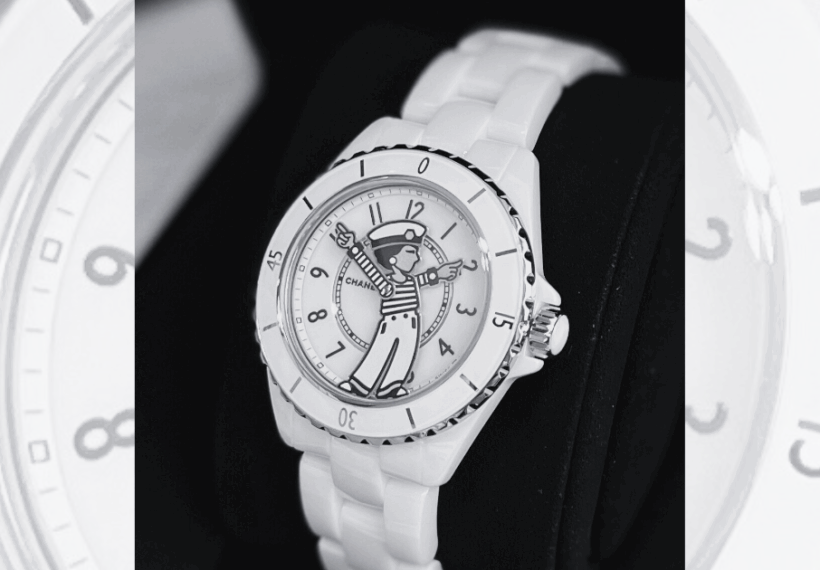A watch is not just a tool that tells time.
Wearing it on your wrist makes the rhythm of each day visible and sets the tempo of your life. While a bag or a dress shapes space, a watch allows you to wear time itself.
Mechanical watches are especially unique, as they run not on batteries but on the power of a wound spring. Each turn of the crown winds the spring, and the second hand starts moving like a quiet heartbeat.
In that moment of winding the crown, you become more aware of time. It feels like something given equally to everyone, and this small action reminds you to truly “mark” each day.
Chapter 1|The Beginning of CHANEL’s Watchmaking Journey
CHANEL began to seriously enter the watchmaking business in the late 1980s. While the maison had a long history in fashion, in the world of watches it was a latecomer.
Luxury watches, cosmetics, and fragrances are all highly profitable areas for luxury brands, and their brand power makes it easier to expand into these businesses. But in the watch industry, Swiss makers held overwhelming history and market share, with long-established houses already in dominant positions.
This made it extremely difficult for newcomers to succeed.
Even so, CHANEL decided to take on the challenge. Just as it expressed its vision through fashion, the house sought to project its aesthetics into “time” and find its own unique interpretation.
How did CHANEL establish its current place in the world of watches? From here, let’s trace that journey.

Chapter 2|CHANEL’s First Watch: The Première
The very first watch CHANEL introduced to the world was the Première, launched in 1987. The case framing the dial — the “face” of the watch — was designed as an octagon, echoing the shape of the cap of CHANEL’s iconic N°5 perfume bottle.
At the same time, this octagonal form also reflected the silhouette of Paris’s Place Vendôme. In this shape were combined all the elements CHANEL valued most: simplicity, iconic design, and a deep connection to Paris.
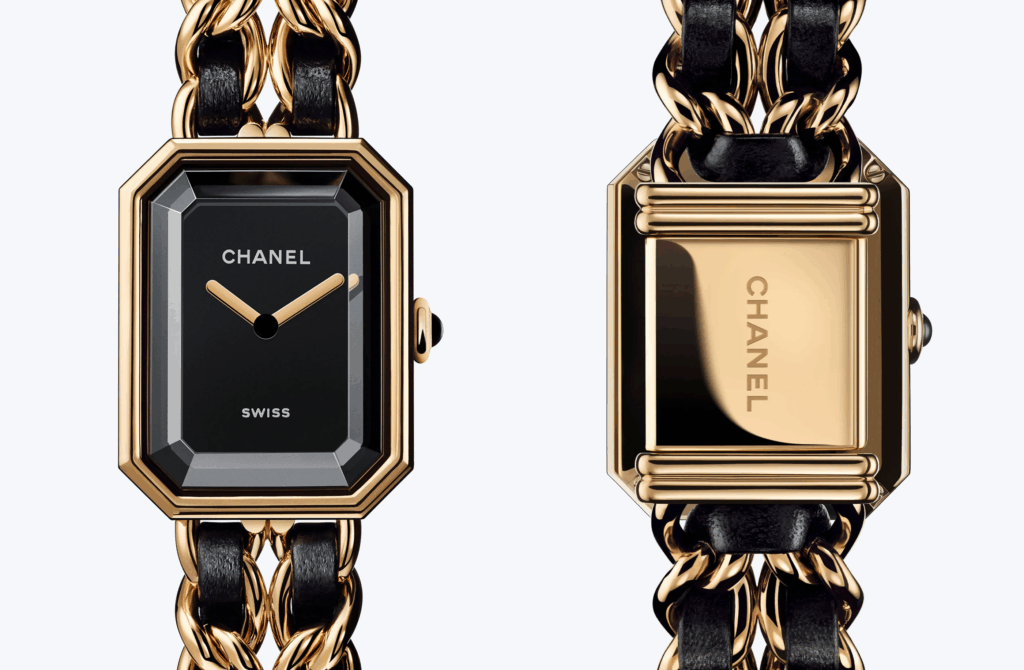
Unlike the traditional Swiss mechanical watch, the Première was powered by a quartz movement. It was created as an extension of fashion expression — a true “fashion watch.”
The dial, designed without a second hand, was not about measuring time to the exact second. Instead, it was meant to make a woman’s wrist look elegant. Positioned between jewelry and fashion, it still carried CHANEL’s signature minimalism.
This balance of practicality and beauty already defined the foundation of CHANEL’s watchmaking philosophy.
The Première was less a tool for measuring time and more an accessory for “wearing time” itself. Looking back, and knowing that the later J12 would mark CHANEL’s recognition as a true watchmaker, this very first step was deeply significant.
Chapter 3|The First Mechanical Watch: The J12
In 2000, CHANEL took on a new challenge with the launch of the J12.
With this model, the house went beyond the idea of a “fashion watch” and stepped directly into the world of Swiss watchmaking at its core — the field of mechanical watches.
What made the J12 truly special was CHANEL’s uncompromising focus on materials.
The house chose high-tech ceramic — a material also used in aviation and space technology. It is as strong as metal, yet lightweight and highly resistant to scratches.
Most importantly, this ceramic reflects light with a distinctive shine, perfectly matching CHANEL’s philosophy of combining functionality with beauty.
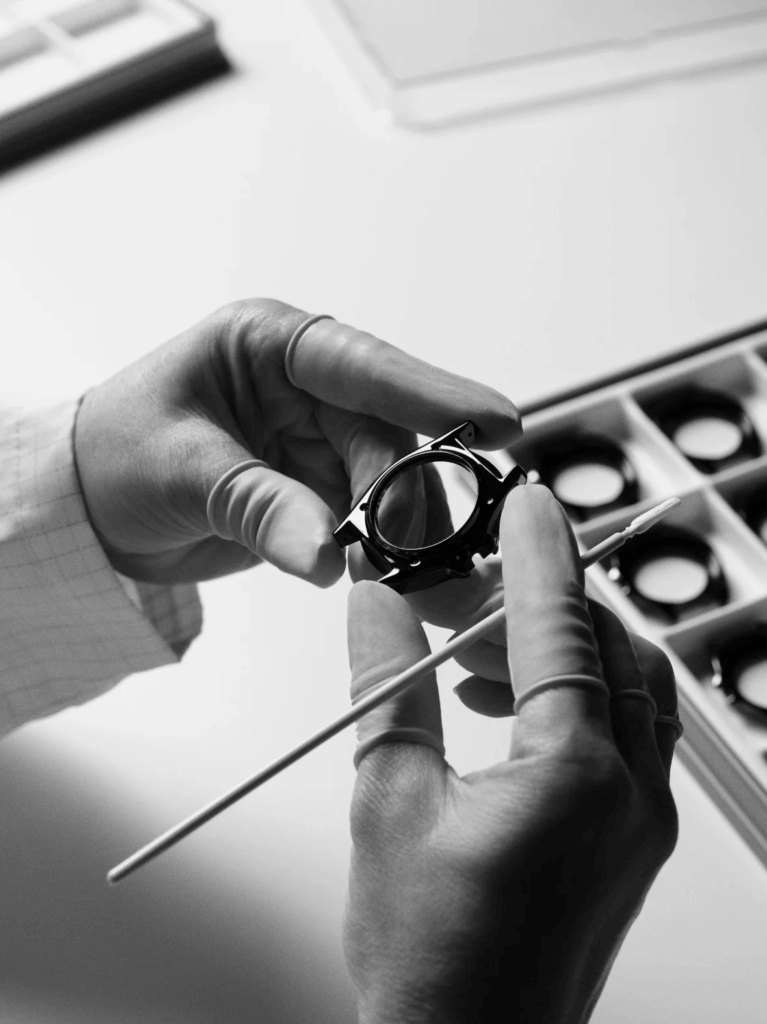
And it wasn’t just a surface coating. CHANEL insisted on shaping the ceramic as a solid block. In the watch industry, producing ceramic this way is considered extremely challenging. The reasons include:
Controlling shrinkage during firing
Ceramic shrinks significantly during the sintering process. According to IWC, “ceramic shrinks by about a third during the baking process,” which means designers must anticipate this shrinkage and adjust their designs and prototypes accordingly. Without this, it would be impossible to produce precise watch components.
For cases and bracelets, tolerances must be within microns, making this an extremely advanced skill.
Source: IWC:Innovative materials – Ceramics
The difficulty of machining and polishing
Once fired, ceramic becomes extremely hard and cannot be cut like metal. As noted by Quill & Pad, “machining and polishing require diamond tools and special abrasives,” highlighting the complexity of the finishing process.
Because of its hardness, ceramic is also brittle and sensitive to shocks, requiring a very high level of expertise to shape it into a reliable watch case.
Source: Quill & Pad:Understanding Ceramics Now Used For Watch Cases
Achieving uniform color
White ceramic in particular is difficult to master. Even tiny impurities or small variations in firing conditions can lead to color inconsistencies, making the pursuit of the perfect white a long and challenging process.
As one CHANEL staff member explained in-store, the J12 White model was not released until the brand was satisfied with the exact shade of white, reflecting the complexity of its development.
After years of unprecedented effort, CHANEL finally achieved success with the J12 — a process that took seven years from concept to completion.
By overcoming these technical challenges, the J12 brought true innovation to the watch industry and elevated CHANEL from being seen as just a fashion house to being recognized as a genuine watchmaker.
What’s more, the J12 was the first time CHANEL expanded its vision to include men, after decades of focusing mainly on women. Interestingly, this step into the men’s market came not through clothing, but through watches. For a house that had always defined women’s style, making this move through a timepiece was highly symbolic.
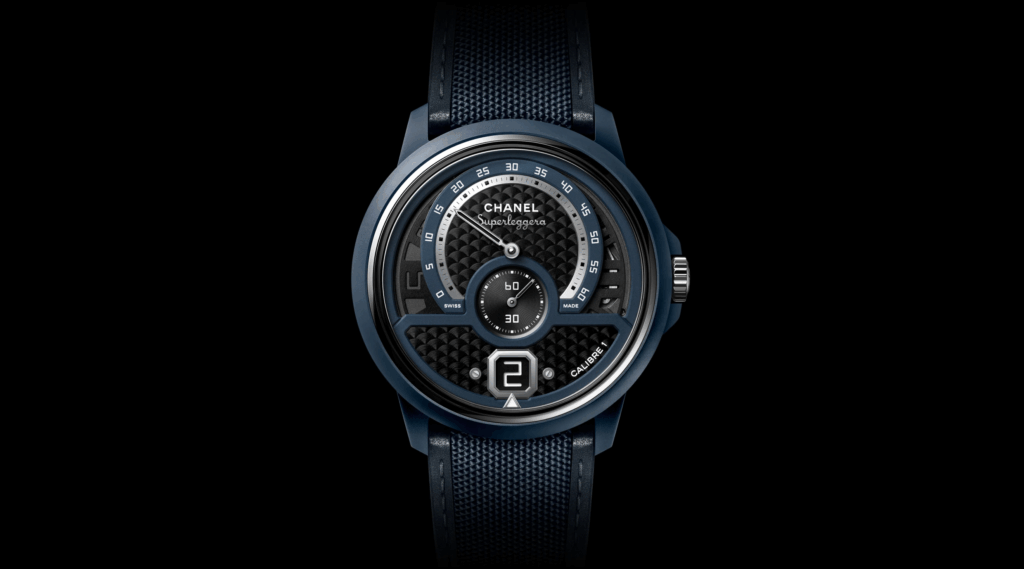
image by CHANEL
Coco Chanel herself was known for transforming men’s fabrics such as jersey and tweed into elegant jersey dresses and chic jackets for women.
The gender-neutral design approach of the J12 can be seen as a continuation of her spirit — a vision of style not limited by gender.
The black J12, with its strength and modern look, became an icon loved across genders. In this way, the J12 expanded CHANEL’s watchmaking, which had begun with women in mind, into the realm of unisex and ultimately into a design with universal appeal.
Chapter 4|Why CHANEL Succeeded Despite Being a Latecomer
Swiss watchmaking traditions span hundreds of years. Historic brands such as Patek Philippe, Rolex, and Audemars Piguet had already built unshakable reputations long before CHANEL entered the field. This made CHANEL a clear latecomer, but it also allowed the house to take a different approach.
Instead of simply following tradition, CHANEL chose to stand out through innovation and aesthetics.
The use of ceramic in the J12 symbolized this direction, and its genderless, modern design presented it as a “universal watch” — not made for anyone in particular, but wearable by everyone.
CHANEL also remained true to its principle of “prioritizing practicality with no excess, while at the same time pursuing beauty.” Neither mere decoration nor just a tool, the J12 gave people a real reason to wear it.
As a result, the J12 became more than just one watch model. It grew into a new brand icon for CHANEL, standing alongside the Matelassé bag and the N°5 fragrance as a lasting pillar of the house.
When I wear the J12 myself, I feel it is more than just a watch — it is CHANEL’s vision of “the beauty of time” on my wrist.
And we cannot forget the playful J12 collections that appear regularly: skeleton models, limited editions set with diamonds, and even artistic designs that reinterpret the very concept of time. These bold experiments have pushed the J12 beyond being a classic, making it a living icon that evolves with each era.
Column|The J12 Experiments That Question “Time”
Among CHANEL’s J12 collections are models that go beyond the classic and challenge the very idea of time itself.
- J12 Rétrograde Mystérieuse(2010年)
This model featured a retrograde mechanism in which the chronograph hand advanced to a certain point and then jumped back. It also introduced an unusual construction where time-setting was not done with the crown but with push buttons on the dial side. Both features created a striking visual effect that differed from traditional watch movements.
- J12 X-Ray(2020年)
With its case, bracelet, and dial all made entirely of sapphire crystal, this model revealed the movement inside, making it fully visible. It was presented as a way to let the wearer visually experience the very mechanism that creates time. By exposing what had always been hidden — the workings that generate time — the watch offered a striking reminder that challenges how we perceive the nature of time itself.
- Mademoiselle J12(2017年〜)
This model places the silhouette of Coco Chanel on the dial, with her arms serving as the watch hands to mark the passing hours. As time moves, her arms change position, creating a look that is both surreal and playful — a perfect example of CHANEL’s sense of humor and creativity. Personally, this is one of my favorite models. I find it fascinating how, when I glance at my wrist, “Mademoiselle” seems to be striking a new gesture each time.
These models show that the J12 is not just a practical timepiece. To me, they prove it is also a creation that playfully — and thoughtfully — questions the very concept of time itself.
Chapter 5|Craftsmanship Proven by CHANEL’s Own Manufacture
One reason CHANEL came to be recognized as a serious player in watchmaking was not only its innovation in design and materials, but also its decision to build its own manufacture and invest directly in technical expertise.
The hub of this effort is in La Chaux-de-Fonds, Switzerland — a historic center of the watchmaking industry. There, CHANEL established its own facility and chose the path of full in-house production, from designing and developing movements to assembling and finishing them.
The symbol of this ambition was the launch of CHANEL’s first in-house movement, the Caliber 1, in 2016. On the official website of the Grand Prix d’Horlogerie de Genève (GPHG), it is described as:
Introduced in 2016, the Caliber 1 is CHANEL’s first in-house haute horlogerie movement, featuring a jumping hour and retrograde minutes.
GPHG: https://www.gphg.org/en/watches/la-montre-monsieur-de-chanel
The GPHG (Grand Prix d’Horlogerie de Genève) is often called the “Academy Awards of watchmaking.” It is run by a public foundation based in Switzerland, with academy members and expert juries evaluating watches through a strict process.
As a result, having the Caliber 1 presented and recognized at the GPHG stands as solid proof of CHANEL’s technical strength and legitimacy in the world of watchmaking.
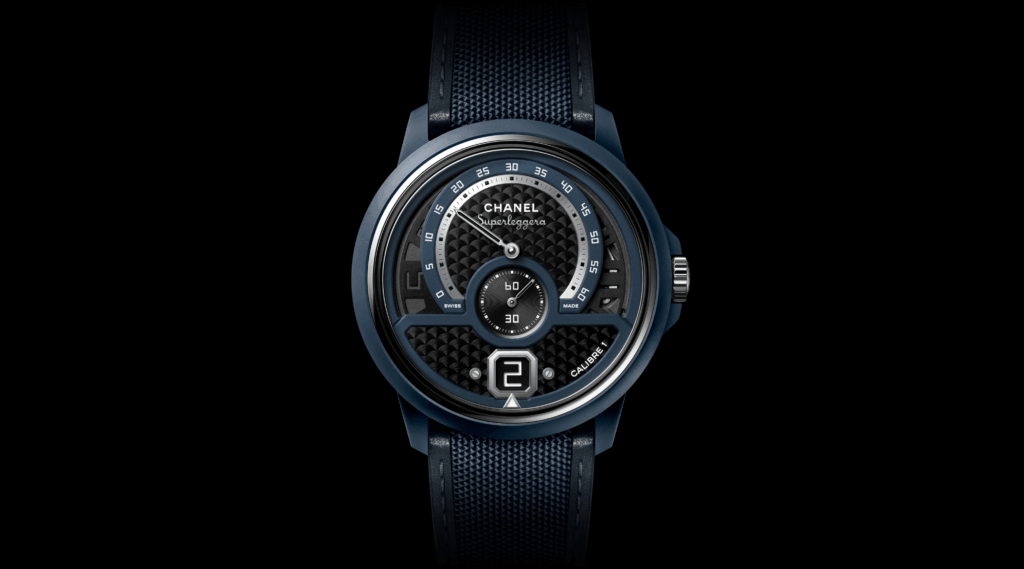
image by CHANEL
The most distinctive features of the Caliber 1 are its jumping hour and retrograde minute display.
The jumping hour shows the time in a small window on the dial, instantly switching to the next hour every sixty minutes. This makes the passage of time feel like a series of leaps rather than a continuous flow.
The retrograde minute display works differently: the minute hand moves along an arc from 0 to 60, and when it reaches 60, it instantly jumps back to 0. That crisp snap of the hand returning delivers a unique dynamism that only a mechanical watch can offer.
According to Time & Tide Watches, the Caliber 1 was CHANEL’s first in-house developed movement and required more than five years of research and development. A-Plus Singapore also noted that it was “fully designed and developed in-house by CHANEL,” underscoring the importance of this achievement.
Time & Tide Watches:
https://timeandtidewatches.com/monsieur-de-chanel-evolves-in-depth/
A-Plus Singapore:
https://aplussingapore.com/interactive/calibres-de-chanel/
In this way, through its own manufacture and years of technical development, CHANEL came to be recognized in the watch world as a true manufacture.
This approach feels like an extension of the “atelier culture” CHANEL had long cultivated in fashion and handbags. Just as Parisian couture houses have preserved and nurtured the skills of artisans, CHANEL chose to value craftsmanship in watchmaking as well — blending technical expertise with a strong sense of aesthetics.
Everything CHANEL creates is designed to meet both functionality and beauty.
That principle holds true in its watches. The J12 brought innovation through its materials and design, and gained real credibility through investment in in-house expertise. In less than ten years since entering the field, CHANEL advanced to stand alongside Swiss watch brands with histories spanning more than a century.
Chapter 6|Conclusion: CHANEL and the Beauty of Time
It has been several decades since CHANEL first stepped into the world of watchmaking.
The Première introduced “a new shape for women,” while the J12 opened the door to “a fusion of innovative materials and mechanical expertise.” Though a latecomer, CHANEL has carved out a clear place in watch history.
CHANEL watches are not just tools to tell time. They hold beauty within stripped-down practicality, while always keeping a sense of playfulness.
Like its bags and fragrances, they carry the power to become timeless brand icons, loved across generations.
And above all, there is that small thrill when winding the crown. As the hands start to move, I feel that time is not simply flowing — it is beginning, chosen, and made my own.
So what does “wearing time” mean to you, in this very moment?
Sources
CHANEL:
https://www.chanel.com/jp/watches/watch-manufacture/
https://www.chanel.com/jp/watches/watch-manufacture/ceramic/
https://www.chanel.com/jp/watches/manufacture-movement-watches/
https://www.chanel.com/jp/watches/watch-manufacture/precise-techniques/
CHANEL Booklet:
PREMIÈRE IN PARIS
LA MONTRE PREMIÈRE ÉDITION ORIGINALE
長沢伸也・杉本香七 編著
『シャネルの戦略 究極のラフジュアリーブランドにみる技術経営』
東洋経済新報社
GPHG:
https://www.gphg.org/en/watches/la-montre-monsieur-de-chanel
Time & Tide Watches:
https://timeandtidewatches.com/monsieur-de-chanel-evolves-in-depth/
A-Plus Singapore:
https://aplussingapore.com/interactive/calibres-de-chanel/
IWC:
Innovative materials – Ceramics
https://www.iwc.com/us-en/specials/innovative-materials
Quill & Pad:
Understanding Ceramics Now Used For Watch Cases
https://quillandpad.com/2015/10/30/understanding-ceramics-now-used-for-watch-cases/
